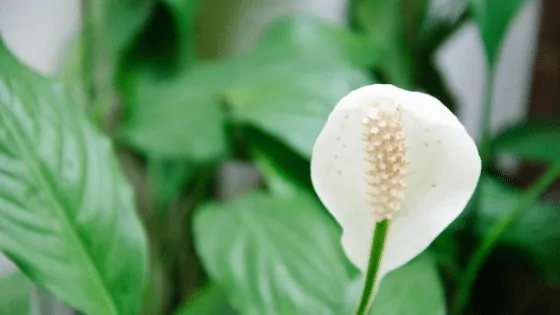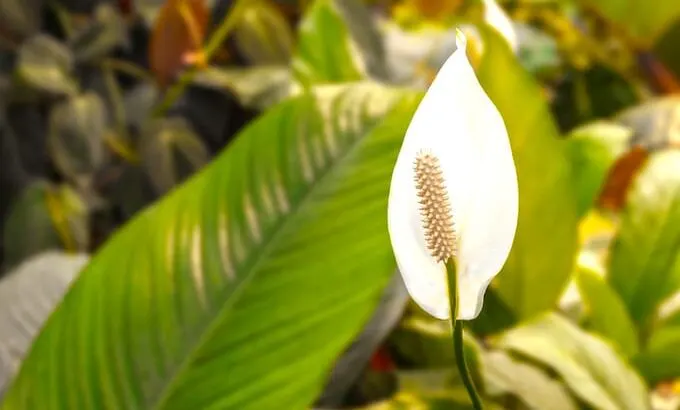Peace Lily Plant Care. Finding a beautiful houseplant to take care of can be a tricky process. Fortunately, the Peace Lily plant has been well-loved among gardeners for its easy keeping. Most Spathiphyllum, or tropical flowering plants, are chosen for their fragrance and ornamental display.
Spathiphyllum is a genus of 47 different species of flowering plants in the Araceae family. Plants in the same family are Monstera adansonii and Philodendron hederaceum. They are all considered to be Aroids (Araceae). A telltale of an aroid plant is that they are flowering plants and produce a spathe and spadix.
In this article, I will discuss how I care for my Peace Lily and keep it blooming year after year.
Peace Lily Care Takeaways
| Species | Spathiphyllum |
| Synonyms | Peace Lily, Arum Lily, Spathe flower |
| Family | Araceae |
| Genus | Spathiphyllum |
| Growth | Clumping, Upright |
| Height | 2 feet (61 cm) |
| Width | 2 feet (61 cm) |
| Soil | Prefers well-draining soil with good organic matter |
| Watering | Every 7-14 days |
| Light | Bright Indirect |
| Temperature | 65-85 °F (18-29 °C) |
| Humidity | 40-60% |
| Fertilizer | Fertilize monthly in spring and summer |
| Propagation | Division of rootball or stem cuttings |
Table of Contents
Peace Lily Care
Keep Peace Lily in slightly moist soil high in well-draining organic matter. They grow best in bright indirect light but can tolerate lower light conditions. The ideal temperature range is 65 to 80 °F (18 and 26 °C). Peace Lily does not tolerate temperatures below 45 °F (7 °C). They can be grown outdoors in USDA zones 10-12. Humidity should be above 50%, 60%, and above is ideal. Fertilize every 6 weeks during spring and summer with a balanced liquid fertilizer at half strength.

Where is the natural habitat of the Peace Lily?
The Peace Lily plant is native to the tropical rainforests of South America, mainly around Columbia and Venezuela. They are known for their iconic white “flowers,” which are actually spathes or modified leaves.
The flowers are tiny and part of the spadix. Paired with dark green leaves, these plants make for a great addition.
Spathiphyllum Growing Guide
Spathiphyllum individuals are relatively easy to take care of, especially indoors.
To keep a plant happy and healthy, several requirements must be met. Here are the care preferences for the Peace Lily houseplant.

Soil
Spathiphyllum plants can live briefly in dry soil, though this isn’t the most conducive setting.
These plants are happiest in soil rich in organic matter that is always somewhat damp.
As long as it drains properly, a simple potting soil will do, as they have no particular demand for a certain type of soil.
Light
The Peace Lily plant does not require much light to survive. For the best results, placing your Spathiphyllum in a room with bright indirect light is ideal.
If you do not have a spot for this with such needs met, you can even grow them with inflorescent lighting.
Watering
To ensure that the roots support your Peace Lily, you’ll want to keep your plant watered.
The top inch of soil should be consistently moistened for a happier Spathiphyllum.
Without slightly moist or overly moist soggy soil, leaves can start to yellow and the spathe won’t develop as profoundly.
Peace Lilies are will get dramatic if underwater. They will droop quite a bit until you might think your indoor plant is a lost cause.
But let me tell you. More often than not I managed to resurrect my Peace Lily with a good drink.
This is not the plant to underwater or forget watering. This Lily will let you know that it is unhappy.
The best water for a Peace Lily is rainwater, reverse osmosis water, or distilled water.
My Peace Lily often gets brown tips from tap water because of the salt build-ups and the chlorine.
Temperature
Like most houseplants, this plant does not like a sudden change in temperature or a cold draft.
They are happiest when kept in a room between 65 to 80 °F (18 and 26 °C ).
These plants do not tend to survive temperatures lower than 45 °F (7 °C).
Peace lily can be grown outdoors in USDA hardiness zones 10-12.
Humidity
The Peace Lily is a tropical plant coexisting in South American rainforests.
Based on this information, it isn’t hard to tell that these individuals prefer high humidity.
A humidity level above 60% is best, but they will tolerate anything about 50% humidity without a problem.
Many Spathiphyllum owners keep them moist using daily misting and humidifiers.
Fertilizer
Fertilize using a balanced fertilizer diluted to half strength.
The typical water-soluble houseplant fertilizer will work. Apply every six weeks during the main growing season in Spring and Summer.
Propagation
You can propagate a Peace Lily through division.
Growth
The typical home-dwelling Peace Lily will grow to 16 feet (40 centimeters), while outside cultivars reach around 6 feet (182 centimeters).
This heavily depends on the type of Peace Lily, as there are dwarf variants and others that grow much bigger.
Bloom
When met with the proper requirements, this species of Spathiphyllum blooms in Spring and might flower again in Autumn under ideal conditions.
The blooms last for 2 months and the white part of the flower is a modified flower called a spathe. The spadix is the “yellow” part and consists of the flowers.
Peace Lilies are aroid plants belonging to the Aracaea genus of flowering plants. All aroids produce a spathe and a spadix.
Potting
Removing your Peace Lily from its original pot once it has outgrown it is paramount for a happy plant. You will have to repot your Peace Lily frequently.
You can expect to need to do this every year, preferably in the spring, as this Lily is a vigorous grower.
Watering
Knowing the difference between too little and too much water is a challenge all plant owners must face.
Understanding how to water your Peace Lily properly will save the leaves from wilting. Given their original habitat, this Spathiphyllum requires a somewhat large amount of water.
Let’s look at a few key points to save you and your plant from over- or underwatering.
How to water
This plant can survive a short drought, which is far from ideal. Instead, you must try to keep the soil moist consistently.
Simply achieve this by watering the entire plant until the water can be seen exiting any drainage holes. These plants do not like to sit in the water, where their roots can become soggy.
When to water
The first rule of thumb with watering a Peace Lily is to take note of the top inch of soil (2.5cm). If dry, give your plant a fair amount of water until it drains out the bottom.
Another indicator can be shown in the plant themselves. One of the easiest ways to identify a lack of water is to observe flopping behavior. Watering will set them right again.
Expect to thoroughly water your Peace Lily once a week, more during the summer growing season.
A commonly discussed way to water your Spathiphyllum is by placing it in the sink. Continue to pour the water slowly into the soil.
Once you’ve noticed that the water escapes through the bottom of the pot, you’ve given it enough water. First, let your plant drain entirely before returning it to its original location.
Water Quality
These individuals are particular in what type of water is used. Surprisingly, the Peace Lily is more sensitive to chemicals than other plants.
These chemicals include common tap water ingredients such as Fluoride. The best water to use is filtered water that is around room temperature.
You do not want to let your plant become too dry. And unfiltered water may cause browning of the leaf tips.
Finding that balance between the right amount of water and the correct water quality can make quite the impact. As stated above, providing your Spathiphyllum with the proper drainage is pivotal.
Propagation
Not every plant owner is comfortable with the idea of propagation. This activity is necessary, however, allowing the plant to continue living in a clone.
Even if you’re new to propagation, the Peace Lily is rather straightforward. The simplest way to propagate this houseplant is through division.
Once old enough, these individuals start to develop a rhizome. These rhizomes are stems that grow horizontally to the soil’s surface. This is where you can prepare yourself for propagation.
The following steps ensure you correctly propagate your Peace Lily to reap the rewards of showy white spathes.
Step 1: Though not entirely important, the easiest and the best time to propagate a Peace Lily is after it blooms. This way, you avoid risking a less-than-ideal blossom.
Step 2: Use your hands or a piece of silverware to gently find the rhizome underneath the soil. Once you’ve identified the desired rhizome, take the plant completely from the pot and rinse away any excess wood.
Step 3: Cut the newly discovered rhizomes into sharp pieces. This can be done with the use of a knife or pruning shears. Make sure that each rhizome has an associated bud or growth point.
Step 4: Use a container to store your new rhizome divisions in a high-quality potting soil mix. These divisions should roughly be the same size as the original Peace Lily in the container.
Step 5: Water your new division until water leaks out from the bottom. Once completed with watering, put them in a spot with indirect lighting.
Step 6: Be sure to check whether more people are on the list. The soil should be moist, not soggy.
Step 7: Check on your newly divided Peace Lily plant, transferring it to a new pot when it grows too big for the current living situation.
Peace Lily Problems
Regarding houseplants, the Peace Lily is pretty easy to keep happy. This does not mean, however, that there won’t be problems later down the road.
Realizing the more commonly found issues is a great preventative measure.
The following paragraphs discuss the problems you may find in a Peace Lily plant, the cause of the potential hazard, and a remedy to help make your individual healthy again.

Yellowing Leaves
Cause: The yellow coloration that you may find in a Peace Lily can result from several different issues.
The most common reason for yellow leaves on a Peace Lily is that the individual has been overwatered.
Remember that these plants tend to yellow with age so it might be related to seniority.
Remedy: If you notice the leaves shift from dark green to light yellow, the first course of action should be letting the plant breathe when it comes to watering.
Allow your Peace Lily to dry out completely, then adjust your watering schedule.
No blooms
Cause: The likelihood of your plant showing little to no progress in producing blooms can be tied to the amount of sunlight.
These plants are somewhat picky regarding light requirements, meaning you can move them around the house until you find the right remedy.
Remedy: Because blooms are related to light exposure, you’ll want to move your Peace Lily to an area with indirect light.
They still need bright sunlight, yet they should not be directly in a window where damage can be sustained.
Leaf Tips Turn Brown
Cause: Another problem that may exist is when the edges of the leaves on a Peace Lily turn brown. The cause for this is once again related to the amount of light exposure. It may also be a result of inadequate humidity.
Remedy: The browning of the leaf edges can be linked-to light or humidity requirements.
You’ll want to tackle one issue at a time to pinpoint the problem.
First, see if your plant starts to heal when moved to an area of the house that is out of direct sunlight.
If that doesn’t work, increase the humidity. The easiest way to accomplish this is to increase daily misting.
How to Keep A Peace Liliy Happy
To simplify things, I have combined a few of the most important takeaways to keep a Peace Lily plant thriving and blooming.
1. Do not overwater your plant. They do not like to be in either drenched or too-dry soil. Add water whenever your plant becomes “saggy” or if the top inch of soil is dried.
2. When watering your Peace Lily, do so with filtered water at room temperature. This is due to their high sensitivity when it comes to chemicals.
3. To keep your plant beautiful and blooming, place it in bright indirect sunlight.
4. Take note of the temperature, ensuring not to have your Peace Lily in a room that drops below 7 °C. The ideal range for these individuals is between 18 and 26 °C.
5. Identify a semi-consistent feeding schedule for your Spathiphyllum. They do not need a lot of fertilizer, averaging about every six weeks.
With all of these tips and tricks, surely you’ll have a happy houseplant. Even with all of this new knowledge, you may still be a little unsure about the care of a Peace Lily. Any unanswered questions can hopefully be addressed below to help you with that.
Toxicity of the Peace Lily
The Peace Lily is toxic to dogs and cats, according to the Animal Poison Control Center ASCPA.
Please do not believe the information on the internet claiming that these plants are not toxic, as this could have negative consequences.
Peace Lilies contain insoluble calcium oxalates or sharp crystals that lead to oral irritation, burning, and irritation to the mouth, lips, and tongue.
Furthermore, intake can lead to vomiting, difficulties in swallowing, and drooling.
Its juices can also irritate the skin and cause burning and swelling. Peace lilies are also toxic to humans.
Therefore, ensure that neither animals nor children are getting in contact with the Peace Lily and avoid any intake.
The Peace Lily is, therefore, not on our list of cat save houseplants.
Frequently Asked Questions
How long do Peace Lilies live?
This Spathiphyllum generally lives around three to five years. This is pretty typical for any indoor houseplant, though some can live longer if provided with the necessary nutrients and needs met.
Do Peace Lilies rebloom?
Peace lilies rebloom with sufficient sunlight, water, and fertilizer. Peace Lilies won’t rebloom in the shade. Flowers appear between late winter and spring.
What are Peace Lilies good for?
This houseplant offers more benefits than simply being a beautiful addition to your floral collection. They have also been proven to purify the air and absorb unwanted mildew, mold, and acetone vapors.
When should I repot my Peace Lily?
Unlike other plants, the Peace Lily isn’t too picky when it comes to being cramped. Though the roots can be too squished, this takes a while. Most Spathiphyllum individuals will show that they need repotting once the roots become tangled.
Closing Remarks
Peace Lilies are great houseplants that are easy to take care of and bloom year after year with the right care.

Daniel has been a plant enthusiast for over 20 years. He owns hundreds of houseplants and prepares for the chili growing seasons yearly with great anticipation. His favorite plants are plant species in the Araceae family, such as Monstera, Philodendron, and Anthurium. He also loves gardening and is growing hot peppers, tomatoes, and many more vegetables.


